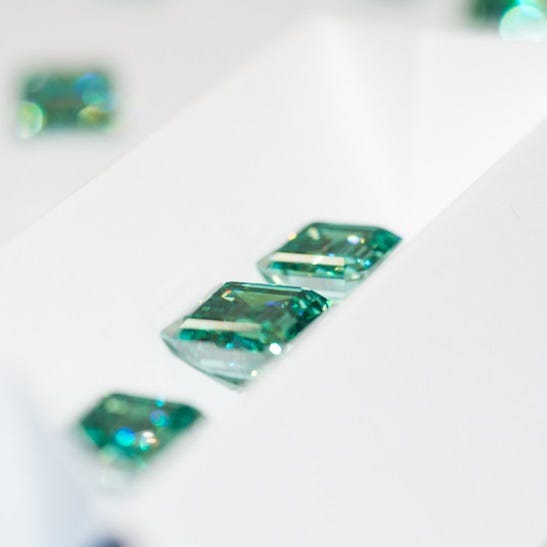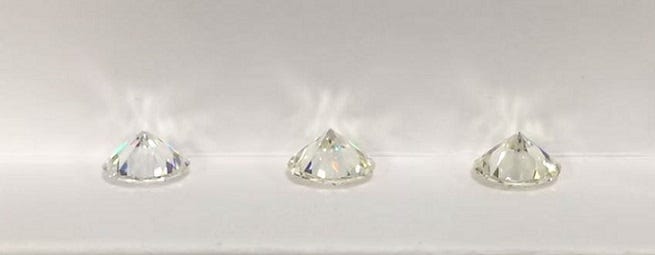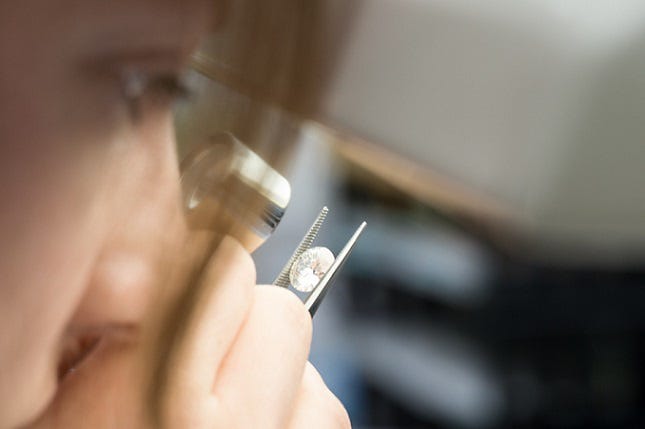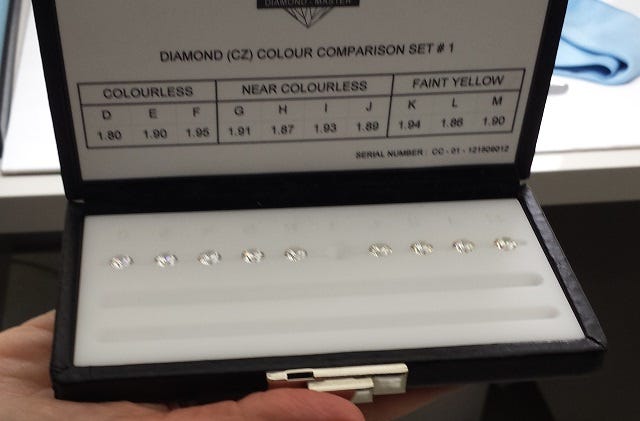Since the release of Forever One™, the first colorless grade of moissanite from Charles & Colvard®, we’ve gotten a lot of questions about how moissanite is graded and what “colorless” really means. This post will show you what goes on behind the scenes during the grading process at Charles & Colvard HQ in Morrisville, NC. We even asked some of the resident experts some of your pressing questions about grading and Forever One™!
You might be familiar with GIA’s (Gemological Institute of America) Diamond Color Grading Scale. Moissanite is actually graded for color using the same scale. However, “color” is a bit misleading; it is a stone’s LACK of visible color that determines its color grade. The GIA color grading scale ranges from D to Z. D is the most colorless (whitest) grade, and Z displays the most color. All moissanite stones sold by Charles & Colvard fall between D and K on the scale.

The grades of moissanite offered by Charles & Colvard® fall into three color categories: Colorless (D-E-F), Near Colorless (G-H-I), and Faint Color (J-K)
If a stone exhibits more color than a Z-grade on the scale, it is considered “fancy-color”. Fancy-color stones are also those that are a color other than white, yellow, or brown. For example, a blue diamond is considered fancy-color, as is a green moissanite. Fancy-color stones are not graded using GIA’s color grading scale.

Fancy-color stones, like these natural green moissanite gems, are graded on a separate scale from normal range stones
So, how do we determine the grade of a particular stone? We asked Charles & Colvard’s Senior Vice President of Merchandise, Production, and Distribution, GIA Graduate Gemologist Bob Curry, a bit about the grading process. He was nice enough to give some of his insight as a true gemstone expert:
How many times is a single moissanite stone graded?
Each stone is reviewed for quality four times. We grade the stones for the first time when they return to Charles & Colvard headquarters in North Carolina after being cut overseas. They are then graded a second time during the cleaning process, and a third time during processing. The final grading is done by the expert Gemological Grader.
Why do you think Forever One™ is such a game-changer?
Moissanite has never existed as a colorless stone until now. The fact that we have been able to create moissanite in D-E-F color is truly amazing. Less than 3 years ago we were struggling to get stones better than I-grade on the color scale, and now we can consistently produce D-grade colorless stones.
We then went to talk to an expert Gemological Grader to get some more scoop! Janice McGowan, a Grading Specialist at Charles & Colvard, was kind enough to answer some of our questions.
How long does it take to grade a single moissanite stone?
About 15 seconds in total. I grade each stone for clarity before grading for color. This involves looking at the stone once through a jeweler’s loupe, then rotating the stone and louping it again to confirm. Once I’ve determined the clarity grade, I then grade for color by comparing the stone to a set of master stones.
How long have you been grading moissanite?
For three and a half years.
What other gemstones have you graded?
My background is in diamond grading. I used to work for an independent grading lab, and I was also a jewelry inspector at Tiffany & Co. I appreciate diamonds for their value and for the rarity of high-quality specimens; however, I find moissanite very beautiful due to its fire and brilliance, as well as its lack of inclusions.

Gemstones set table-down, pavilion-up for grading. Stones are graded loose (not set) against a white background under special lighting to avoid color contamination
Do you get excited when you find a Forever One™ stone?
Well, when I’m given a batch of stones to grade, I usually know if they’re likely to be Forever One™ or Forever Brilliant®. I do get excited when I find a D-grade Forever™ One stone, though. The first time it happened, I could hardly believe it!
What’s your favorite moissanite cut?
Radiant cuts! I love them. Since working with moissanite, I’ve also gained a new appreciation for marquise and princess cuts. I used to grade a lot of marquise and princess cut diamonds, and they were the cuts that tended to be very included. With moissanite, I’ve discovered how beautiful these cuts can be when the clarity is high.
Thank you to Bob and Janice for answering our pressing grading questions. We hope you enjoyed this behind-the-scenes look at moissanite production and grading. Stay tuned for more educational posts!




